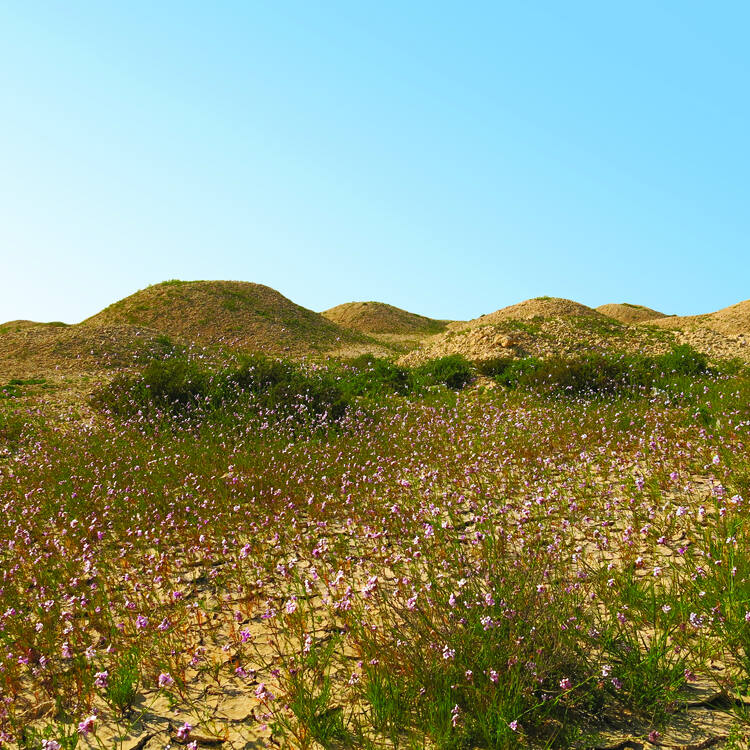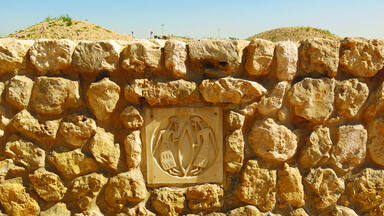Dilmun Burial Mounds
Dilmun Burial Mounds
Description is available under license CC-BY-SA IGO 3.0
Tombes de la culture Dilmun
Description is available under license CC-BY-SA IGO 3.0
مدافن دلمون الأثرية
source: UNESCO/CPE
Description is available under license CC-BY-SA IGO 3.0
迪尔穆恩墓葬群
source: UNESCO/CPE
Description is available under license CC-BY-SA IGO 3.0
Могильные курганы Дильмуна
source: UNESCO/CPE
Description is available under license CC-BY-SA IGO 3.0
Tumbas de la cultura dilmun
source: UNESCO/CPE
Description is available under license CC-BY-SA IGO 3.0
Outstanding Universal Value
Brief synthesis
The Dilmun Burial Mounds is a serial property formed by 21 archaeological sites located in the western part of the island of Bahrain. Six of the selected site components are burial mound fields consisting of some dozen to several thousand tumuli. Together they comprise about 11,774 burial mounds. The remaining 15 site components consist of 13 single royal mounds and two pairs of royal mounds, all embedded in the urban fabric of A’ali village.
The Dilmun Burial Mounds were constructed during the Early Dilmun Period over a period of 450 years, approximately between 2200 and 1750 BCE. The property encompasses the most representative sites of Early and Late Type Dilmun Burial Mound construction. The burial mounds bear witness to the flourishing of the Early Dilmun civilization around the 2nd millennium BCE. During that period, Bahrain gained economic importance on an international level as a trade hub which led to population growth and, as a consequence, to a more diversified social complexity. The latter is best reflected in the extensive necropoli with their variety of graves, comprising burial mounds of various sizes, as well as chieftain mounds and the grandest of them all, the royal mounds.
Archaeological evidence shows that the burial sites were originally not constructed as mounds but as cylindrical low towers. The royal mounds, characterized by their pronounced sizes and elaborate burial chambers, were constructed as two-storeyed sepulchral towers forming a ziggurat-like shape. Two of the last Dilmun kings have been identified as Ri’ Mum and Yagli-‘El in relation to the royal mounds 8 and 10.
The Dilmun Burial Mounds illustrate globally-unique characteristics not only with regards to their numbers, density and scale but also in terms of construction typology and details, such as their alcove-equipped burial chambers.
Criterion (iii): The Dilmun Burial Mounds represent unique sepulchral testimony to the Early Dilmun civilization over a period of 450 years. As remains of settlements are scarce and buried under thick layers of soil, the Dilmun Burial Mounds are the most extensive and most apparent evidence of the Early Dilmun culture. At the time, the newly gained prosperity allowed the island’s ancient inhabitants to develop an elaborate burial tradition applicable to the entire population. The excavated mounds provide a cross section of various social groups in the Early Dilmun society, attesting to thousands of individuals of different age, gender, and social class. They also offer crucial evidence on the evolution of elites and ruling classes. The ancient inhabitants of Bahrain understood the special geological configuration of the island and used less fertile land for the development of these extraordinary cemeteries.
Criterion (iv): The evolution of the Early Dilmun civilization is reflected in the architecture of the Dilmun Burial Mounds. Five different mound types give clues about the emergence of social hierarchies. Even though the burial mounds can be divided according to variations in size and interior design, the basic layout of the mounds remains the same throughout the 450-year period. The construction typology is exceptional. The majority of the tombs were constructed as single-storeyed small cylindrical towers while some of the bigger two-storeyed examples were built in a ziggurat-like shape. A very particular and unique characteristic of the Dilmun tumuli construction is the presence of alcoves. Depending on the occupant’s social status there can be up to six of such alcoves which were usually filled with mortuary gifts.
Integrity
The serial property displays the original distribution of Early and Late Type Dilmun Burial Mounds, organized in individual cemeteries. It excludes two fields which provide evidence of the great majority of Early Type Early Dilmun Burial Mounds (Wadi as-Sail and Umm Jidr) which are planned to be nominated as an extension in a second nomination phase. The five distinct types of burial mounds reflect a hierarchy of the ancient population and present a cross section of various social groups of the Early Dilmun society.
Most of the tumuli have not been excavated and their fabric is completely intact, solely impacted by occasional ancient looting and natural erosion that has transformed the once sepulchral towers into mounds. As a result of previous development activities, the setting has lost parts of its integrity. In particular the direct vicinity of residential developments affects the visual integrity of some of the property components. However, urban developments have come to a halt due to effective arrangements in the protection and management of the site. Corrective measures are underway and include the introduction of green belts around the ancient cemeteries in order to improve their visual setting.
Authenticity
The serial property is authentic in terms of its location, function, material and substance, form and design, as well as density. Despite having been impacted by erosion and partially by looting in ancient times, the mounds’ architecture, layout and interior design remain intact. The particular characteristics and distribution of Early and Late Types of Early Dilmun Burial Mounds within the cemeteries are excellently displayed. The density of fields in a limited area is exceptional as well as the unique concentration of burial mounds within each cemetery.
Management and protection requirements
All site components of the Dilmun Burial Mounds serial property are registered as National Monuments and are protected according to the Kingdom of Bahrain Legislative Decree No. 11 of 1995 concerning the Protection of Antiquities. The restrictions for urban development within the buffer zones of the site components are integrated in the Land Use and Zoning regulations which are subcategories of the Physical Planning Legislation of 1994. Site administration is carried out by the Bahrain Authority for Culture and Antiquities. A unit with the Directorate has been designated for the administration of the property.
The Dilmun Burial Mounds Management Plan has been approved and effective since January 2018 for a period of five years, including long-term objectives for the site. It is envisioned as an integrated management and action plan with the following key strategic themes: administration and finance, land ownership and development, research, conservation, awareness-raising and community involvement, as well as interpretation, presentation and visitor management. The management plan works also as a protection plan as it addresses the main threats to the site components, which are development pressures, pollution and erosion.

